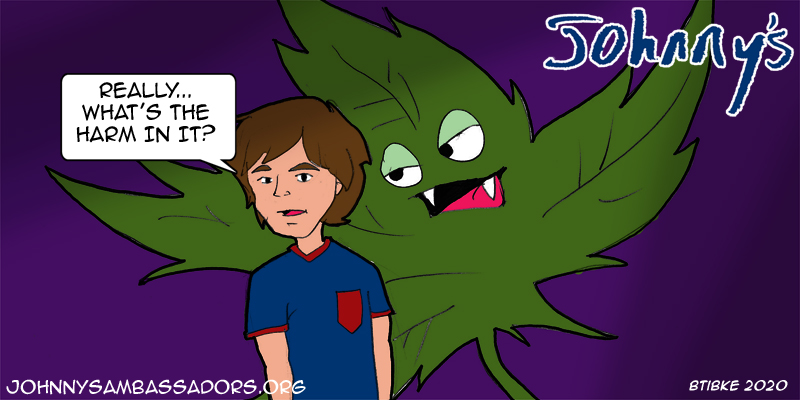By Laura Stack
With more states legalizing marijuana, it’s incumbent upon us as loved ones, parents, grandparents, counselors, teachers, and concerned adults, to protect the vulnerable. Marijuana isn’t legal until 21 years of age, and there’s a good reason for that—it harms the developing mind when used during adolescence. This is a well-known, undisputed fact. The problem is that with so many states legalizing, children can get the impression there’s “no harm in it.” As it becomes normalized and just sort of always available and constantly around, we must work even harder to reduce the gap between their perception and the actual harms of marijuana. It’s up to us!
But using the terms “adolescents” or “teens” can prove misleading. It can result in us forgetting one age range during which our young people are legally but not physically adults, when marijuana can still cause terrible damage: the 18-to-20-year old’s. Not only are young adults this age typically away from their parents for the first time, and thus able to enjoy freedoms they’ve never had, in some states they can get marijuana surprisingly easily—even legally if they can get a “doctor” to give them a medical marijuana card at 18.
Now, the marijuana usage statistics for adolescents 12-17 aren’t pretty, but they haveremained relatively steady since about the year 2000. The problem is they are using more higher-concentrate THC marijuana products, which have compounded the mental illness problems. According to the Youth Risk Behavior Surveillance System (YRBSS) for 2019, a scary 36.8% of American high schoolers have tried marijuana at least once, with about 10% of middle schoolers also having tried it. However, most aren’t habitual users. The 2019 National Survey of Drug Use and Health (NSDUH) reveals the overall past-month use rates for adolescents 12-17 was at 7.4% (one in 14, a bit higher than 2017). Meanwhile, marijuana use rates for young adults 18-25 have skyrocketed to almost 50%, according to NSDUH.
So? Why Worry?
Because 18 is just an arbitrary date for maturity, set by law rather than reality. Biologically, most 18- to 20-year-olds haven’t yet reached full adulthood. Marijuana may scar a young person for life if they use it during this age range. Indeed my (surviving) son, James, is 19, and he has friends who are daily users.
Brain development is especially relevant here. The human brain continues to develop until up to age 25. A colt or calf can walk within minutes or hours after birth; humans can’t, because if our brains developed that far before birth, our heads would grow much too large for us to be born safely. For the fantastic gifts of culture, creativity, mental elasticity and more, we undergo post-natal brain development.
Chemical insults to the developing human brain can cause irreparable harm. This is especially true when brain chemicals called endocannabinoids (anandamide) get replaced by the cannabinoids present in marijuana. Cannabinoids not only act as a “dimmer switch” that slows brain function and makes users stupider (by as many as 6-8 IQ points, permanently), they also block further brain development controlled by endocannabinoids.
Even in relatively small amounts (as little as one hit), modern high-THC weed use by youths can case:
- Cannabis Use Disorder
- Brain damage
- Anxiety
- Panic attacks
- Depression
- Paranoia
- Psychosis
- Increased risk of schizophrenia
- Suicidal thought and behavior
Add marijuana toxicity, the recently defined vaping disease EVALI, and the wheezing cough inhaling marijuana smoke often causes, and it suddenly becomes much less “harmless” and much less acceptable.
Regarding the Gap
Recent surveys have made it clear that the general public is steadily becoming more and more convinced marijuana poses no significant danger. In some parts of the U.S., it’s become entrenched in our culture; as of 2019, for example, Colorado (where recreational use has been legal since 2014) had more marijuana dispensaries than Starbucks and McDonalds franchises combined, a startling statistic.
But all is not peaches and honey for the nascent Big Marijuana. I’m pleased to note that modern marijuana’s dangers are slowly becoming more recognized in pop culture. For example, the officers on most police procedural TV series still highly disapprove of the drug (as most do in real life), and on another series, a head of a mental institution recently retorted to a colleague with whom she was arguing, “You know, that bad weed can make you paranoid.”
On another show, however, a coroner commented over the dead body of a cannabis entrepreneur that, ironically, it was the “one drug that doesn’t kill,” though it could be argued that his pot-fueled, debauched lifestyle led to his death. Let’s work toward a rebirth of the concept that marijuana is not okay, that it’s not just some harmless good-time drug. Talk about it to your kids. Mention the ads you see and the shows you watch. Read stories like Johnny’s to them. If we don’t, young people will become increasingly convinced it’s safe. When a “friend” shows up at a party with a dab pent and says, “Here, hit this,” will they even know what it is, and will they understand the harms? It’s up to us to narrow that gap!


